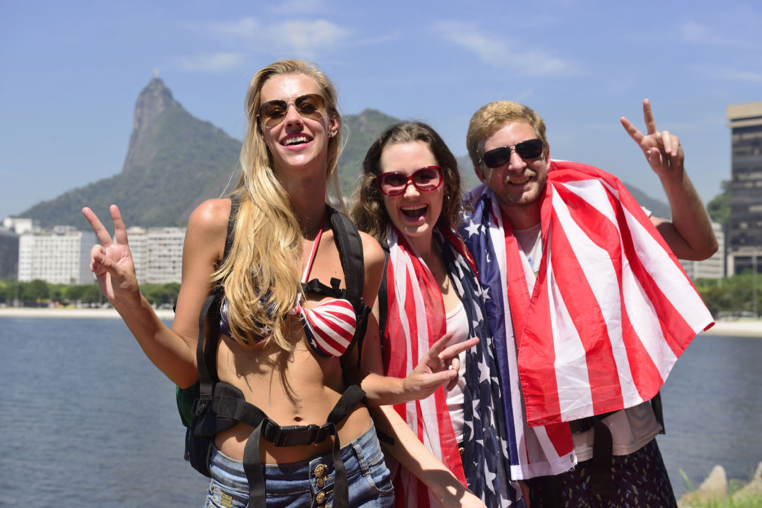Here are 20 tips to help you blend in, avoid offense, bond with locals, and stay safe.

A reader wrote, “I’m planning a three-week trip to countries in Asia and Europe for when we can travel internationally again. I know more of the world is dressing casual (especially during the pandemic), but I don’t want to stand out as an American. Ideas?”
Dressing and acting appropriately while traveling abroad not only helps you fit in with locals and receive friendlier service, but also protects you from standing out to pickpockets. Here are 20 suggestions:
1. Don’t wear T-shirts, hats, or anything with political words or symbols on them (including U.S. flag and red MAGA baseball caps).
2. Avoid religious jewelry (Christian crosses, Stars of David), or at least wear it so it can’t be seen.
3. Leave the baseball caps and t-shirts printed with sexist jokes, ethnic slurs, and stupid sayings at home. Ditto for t-shirts featuring beer or alcohol brands, especially in the Middle East.
4. Forgo pricey designer wear and flashy jewelry. You’ll be a walking magnet for pickpockets.
5. In many parts of the world, sneakers are for sporting activities only; flip flops and Birkenstocks are frowned upon as streetwear. Instead, wear comfortable leather walking shoes, and keep them polished and in good shape. Nothing screams “American tourist” like lace-up, American-brand, color-clashing-with-your-outfit sneakers. And don’t get me started on the Velcro models.
6. If you’re a guy, no one wants to see your bare toes in sandals or your hairy armpits and chest in a tank top. Really.
7. Unless bold hues are the norm where you are traveling, stop at a splash of color (no neon pink dresses).
8. Dress conservatively in any country holding deeply religious views, such as those in the Middle East. Women in particular should avoid miniskirts, tank tops, bra tops, short-sleeved shirts, shorts, and sometimes even capri pants. (I was yelled at for showing my ankles and wrists in Turkey.) No revealing dresses or cleavage-bearing necklines. When in doubt, look at what the locals are wearing. Leave room in your suitcase to buy some items once you arrive, like a scarf or a hat. That way, you gain the experience of shopping like a local, blend in better,and come away with great souvenirs.
9. Americans love their shorts, but people of other cultures (Indonesians, Vietnamese, Emirati, to name a few ) don’t wear them for everyday walking around, no matter how hot it is. Save them for beaches, parks, and hiking trails. And leave your cargo ones home.
10. American travelers are known for wearing athletic clothes, sneakers, or even pajamas when they aren’t working out or sleeping because they favor comfort over fashion. But there’s no reason you can’t have both! Jeans should fit well and be wrinkle-free, and preferably black or dark blue. Baggy or ultra-ripped models are frowned upon in some cultures, and you may come across as disrespectful if you wear them into churches, mosques, or other holy sites.
11. Planning to spend the summer backpacking across Europe or Southeast Asia? A large backpack is probably a better choice than a rollaboard suitcase for lugging onto trains and traveling between destinations. But bring a secondary bag, preferably one that can be worn crossbody, for everyday touring around cities. Any kind of backpack, big or small, marks you as a tourist. They’re also easy to reach into and steal from if you’re wearing one on your back in a crowd or on a busy bus or train.
12. “Ugly Americans” speak loudly and draw attention to themselves. Remember when you travel, you’re like a guest in someone else’s house. Keep your sound level low and your speech polite. Speak to the people of your host country with respect.
13. While it’s human nature to speak more loudly when you feel as though you’re not being understood, if you don’t share a common language with the person you’re talking to, no amount of volume increase will help the other person make sense of what you’re saying. Use a translator app or gadget instead. And instead of starting off a conversation by asking, “Do you speak English?” (in English in a country where it’s not the main language), try leading with “Hello” in the local lingo.
14. Mind your photo-taking etiquette. It’s often against the law to photograph government buildings, military installations, policemen, guards, children, and parts of airports and train stations. And unless you’re a pro photographer, snap a photo or two, then put the camera away. Nothing marks you as a tourist like a camera permanently hanging from your neck. Not only do you stand out, but you may also be targeted by thieves.
15. Be wary of hand gestures, both making them and wearing clothing depicting them, because they can have different meanings depending on where you are. For example, in Bangladesh the “thumbs up” gesture is considered obscene. (Yes, I learned this the hard way.) Check Google for info on common local gestures and taboos.
16. Know the country’s rules and customs. In Turkey, shaking your head means, “I don’t understand. Say it again;” to say No, click your tongue and toss back your head. Never pour yourself a drink in Japan; serve the others and wait until they serve you. When flagging down a taxi in Peru, extend your arm out level and wave downwards towards your body; putting your open palm up like as a stop signal is considered very rude. (These are some of the many faux paus I’ve committed when traveling. Now I Google “etiquette and customs of [Country X]” when going someplace new.)
17. Ask questions that show you care and can relate. Conversation topics to raise with locals could include asking about their jobs, where else they’ve traveled, what they’d like to see if they were to visit America, what their medical care and school systems are like, how women’s role in society is changing, etc. Such questions will establish similarities, as well as interesting differences, between your life and those of the people you meet.
18. A private English-speaking guide, arranged via the internet, a reputable tour company, or your hotel concierge can quickly get you up to speed on native norms and introduce you to receptive local people. Feel free to ask him/her about dress, dining, and other customs.
19. Another ugly American stereotype is the tendency of some travelers to bash the local culture, even if it’s framed as “it’s so weird that you…” or “In the States, we do it this way….” Research local cultures and customs before a trip so you’ll have some background on why certain things are done. Or if you don’t know why, ask instead of jumping straight to criticism.
20. Traveling can take you out of your comfort zone, and sometimes you just want to eat something that reminds you of home. Doing this while abroad, however, can contribute to the stereotype of the ugly American who only wants to eat hamburgers and hot dogs. Instead of seeking out American food, why not find something that reminds you of home but is still an adventurous way to taste another culture? For example, consider checking out a chain that doesn’t yet in the U.S., like Pizza-La in Japan, Supermac’s in Ireland (I love the garlic and curry fries), MOS Burger in Asia and Australia (check out the Pork Ginger burger served between two patties of rice instead of buns), Teremok in Russia (blinis—think pancakes stuffed with sweet or savory filling, including caviar), or Chicken Licken in South Africa and Botswana (chicken served any way you like).
Twist’s Take: When traveling, try to be an ambassador for the U.S.A. instead of a bad example.
